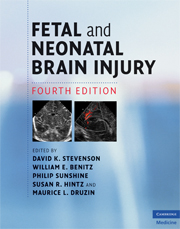Book contents
- Frontmatter
- Contents
- List of contributors
- Foreword
- Preface
- Section 1 Epidemiology, pathophysiology, and pathogenesis of fetal and neonatal brain injury
- Section 2 Pregnancy, labor, and delivery complications causing brain injury
- Section 3 Diagnosis of the infant with brain injury
- Section 4 Specific conditions associated with fetal and neonatal brain injury
- Section 5 Management of the depressed or neurologically dysfunctional neonate
- Section 6 Assessing outcome of the brain-injured infant
- 45 Early childhood neurodevelopmental outcome of preterm infants
- 46 Cerebral palsy: advances in definition, classification, management, and outcome
- 47 Long-term impact of neonatal events on speech, language development, and academic achievement
- 48 Neurocognitive outcomes of term infants with perinatal asphyxia
- 49 Appropriateness of intensive care application
- 50 Medicolegal issues in perinatal brain injury
- Index
- Plate section
- References
46 - Cerebral palsy: advances in definition, classification, management, and outcome
from Section 6 - Assessing outcome of the brain-injured infant
Published online by Cambridge University Press: 12 January 2010
- Frontmatter
- Contents
- List of contributors
- Foreword
- Preface
- Section 1 Epidemiology, pathophysiology, and pathogenesis of fetal and neonatal brain injury
- Section 2 Pregnancy, labor, and delivery complications causing brain injury
- Section 3 Diagnosis of the infant with brain injury
- Section 4 Specific conditions associated with fetal and neonatal brain injury
- Section 5 Management of the depressed or neurologically dysfunctional neonate
- Section 6 Assessing outcome of the brain-injured infant
- 45 Early childhood neurodevelopmental outcome of preterm infants
- 46 Cerebral palsy: advances in definition, classification, management, and outcome
- 47 Long-term impact of neonatal events on speech, language development, and academic achievement
- 48 Neurocognitive outcomes of term infants with perinatal asphyxia
- 49 Appropriateness of intensive care application
- 50 Medicolegal issues in perinatal brain injury
- Index
- Plate section
- References
Summary
Overview
Cerebral palsy (CP) is a neurodevelopmental disorder. It begins in early childhood and is a lifelong condition. Core features include abnormal movement and posture due to impairments in coordination and/or muscle tone. CP is not an etiologic diagnosis. Rather, it is a descriptive term based on an individual's clinical picture. Among children diagnosed with CP, there is great heterogeneity with respect to etiology, type of impairment, and severity of impairment. Brain disturbances that lead to CP may occur prenatally, perinatally, or in the young child during brain development and maturation. Although the brain disturbances leading to CP are not progressive, the clinical picture is not static. Clinical features of CP evolve with time, development, learning, motor training, and therapy. The disorder can potentially lead to poor growth of a limb, contractures and poor range of motion, pain secondary to spasticity, inability to complete voluntary movements, neglect of a limb, inability to complete activities of daily living, and poor participation in the community.
CP is the most common cause of physical disability in children. Based on classic definitions for the disorder, 2–3/1000 live births are affected by CP. The prevalence of CP is 77/1000 children for those born less than 28 weeks gestation and 40/1000 in children born between 28 and 31 weeks gestation. The total lifetime costs for those born with CP in the USA in the year 2000 will be $11.5 billion, based on the 2003 dollar value.
- Type
- Chapter
- Information
- Fetal and Neonatal Brain Injury , pp. 556 - 563Publisher: Cambridge University PressPrint publication year: 2009



